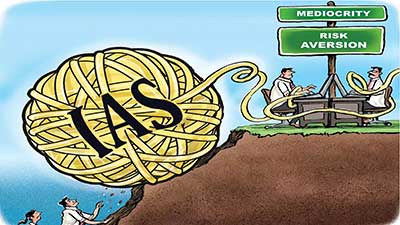Relevance: GS-2 : Role of civil services in a democracy.
Key Phrases: Meritocracy,Mediocrity, Sycophancy, Legitimate turf,Bulwark,Failed Bureaucracy,Lateral Entry ,Mission Karmayogi, Domain Specialisation
Why in News?
- Two recent articles on the failure, or otherwise, of the Indian Administrative Service (IAS) have attracted public attention.
- The article argues for true meritocracy, faults the system of incentives and disincentives that rewards mediocrity, and makes it clear that the failure is not all due to political context and interference.
Whether IAS officers have performed as per goals of India’s Constitution and Citizens expectations?
- The answer is not uni-dimensional. In the last 75 years, the nation’s track record has been impressive, though not an unmixed one.
- Every metric has attested to steady growth in income, health and educational attainments.
- Nevertheless, our human development index is pretty low, inequality is staggering, and substantial sections of our population still live in appalling conditions with access only to low quality public services.
- This indicates the scale of the task still unaccomplished.
Reasons for Failing Bureaucracy:
- In the complex interplay between elected representatives and selected officials within the Constitutional arrangements that define areas of governance between Indian states and the Centre, IAS officers have to tread carefully.
- Certain defining moments in the evolution of the service that
have apparently affected its fabled competence, commitment and
integrity:
- Imposition of Emergency in 1975:
- In the 50s and 60s, much of India was ruled by one party, and inexperienced ministers depended heavily on the higher bureaucracy to run the administration, with many of them in awe of ICS and IAS officers.
- With the passage of time and different political parties gaining ascendency, the epicentre of power started shifting from the bureaucracy to the political leadership.
- The Emergency exposed fault lines,commitment to the party in power was demanded and often ensured. This caused immense institutional damage.
- Exceptions apart, rewarding pliable officers and ignoring others became a norm impacting ethos of service.
- Changed profile of regular IAS recruits:
- Expanded affirmative actions from the early 90s started altering the nature of direct recruits, making the civil services more inclusive of our social structure.
- However, responding to the demands of deprived sections, the upper age of entry and number of attempts allowed for the competitive examination were increased.
- Consequently, the average age of entrants rose substantially. The career profile and level of motivation would be different, say, for one selected at the age of 21 and another at 35.
- Alongside, liberalisation of the economy from 1991 started expanding job opportunities, so the IAS was no longer the preferred option for many young Indians.
- Further, its long three-stage examination process has acted as a dampener for the brightest of aspirants.
- Complex decision making of executive:
- Following liberalisation, executive decision-making has turned enormously complex, especially in the economic sphere involving private sector participation.
- Unfortunately, the need for specialisation in broad sectoral areas, once the officers complete their first decade of field immersion, is yet to be taken seriously.
- Recent initiatives like Lateral entry and Mission Karmayogi are important, but hardly adequate.
- One reason for the IAS not fulfilling the needs of an aspirational citizenry is its inadequate domain knowledge.
- Failure to protect the legitimate turf:
- The IAS, not being a cohesive system, has failed to protect its legitimate turf in furthering the public good while the judiciary and legislature have fiercely protected theirs.
- When government actions are questioned in the legislature or courts, propelled often by political considerations, it is primarily the officials, sometimes after retirement, who have to defend decisions.
- Accountability to multiple agencies, being exposed to reputation-ruining allegations by the media, and having to face investigative agencies and courts even when their decisions were bonafide have made officers risk-averse.
- Also, lucrative post-retirement benefits offered to a chosen few, not always based on performance, have promoted a culture of sycophancy.
- Imposition of Emergency in 1975:
Is political interference the sole cause for inefficiency?
- While illegitimate political interference in administrative work is widely prevalent, there is no denying this is used by many as an excuse for non-performance.
- For example, the acute shortage of IAS officers that recently sparked a Centre-state confrontation is largely an official failure to plan. IAS performance and its image are not always linearly correlated.
- Though there is no clear evidence of a declining standard of administration, the service’s image has been dented.
- Evidently, only those institutions have retained a better image that operate broadly in an apolitical environment and are not accountable to the public at large.
Conclusion:
- Reforming the IAS and restoring its image would depend on how seriously we address these real questions.
- Nevertheless, the fact that an overwhelming majority continues to serve quietly in maintaining the unity, integrity and the federal character of the nation, often acting as a bulwark against authoritarian tendencies, and steering it to a path of prosperity, should not be underestimated.
Source: Live-Mint
Mains Question:
Q. IAS officers as leaders of bureaucracy have failed to perform as per the expectations of Indian citizens and goals of India’s Constitution. Critically evaluate. (250 words).









